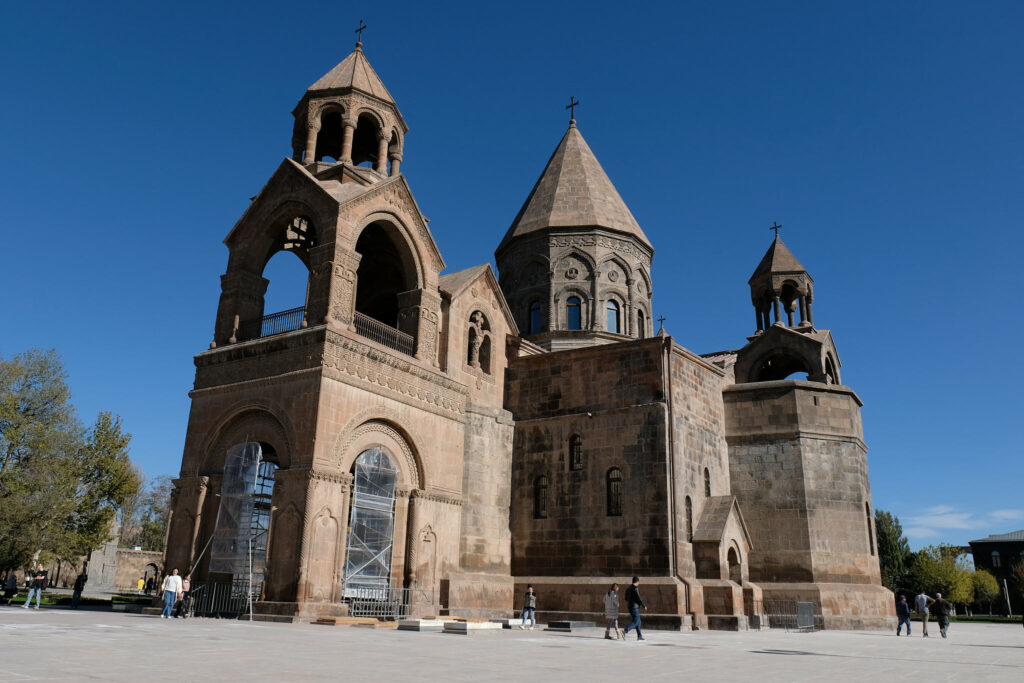With Armenia in turmoil after losing the war, many fear that Nagorno-Karabakh’s cultural heritage is at risk of destruction. Will satellites and treaties protect the region’s iconic landmarks?

by Florian Guckelsberger
The chimes of St. Thaddeus Church ring out brightly. They effortlessly drown out the cries of the children in the nearby playground, and even the old men in the park look up briefly. In Masis, deep in the west of Armenia and just a few kilometers from the border with Turkey, a wedding is taking place today. The lost war is forgotten, at least for a few hours.
Beniamin Saturyan stands apart from the wedding gathering in the sun. The priest fled the embattled region of Nagorno-Karabakh a few weeks ago. He is one of 100,000 people who, fearing for their safety, sought refuge in the Armenian heartland since mid-September, following the Azerbaijani victory.
“I wore comfortable clothes when I fled, as we were in the car for more than a day. My mother had asked me not to wear a cassock so that the Azerbaijanis wouldn’t see that I was a priest. I have no doubt that they were targeting people like us. If they had already tortured ordinary believers, what would they do to us? We were threatened with death,” Saturyan recalls.
The latest clash between the hostile nations lasted a mere 25 hours – then the Armenians surrendered. In addition to their houses and belongings, they also left behind something else: their Christian heritage embodied in churches, monasteries and exquisitely carved cross-stones, known as “khachkars.” Beniamin Saturyan is deeply worried:
“We have seen what happened to the khachkars and other monuments in Nakhichevan and even in Baku. That is why we believe that the churches and monasteries in Nagorno-Karabakh will face the same fate. Perhaps we will succeed in preserving at least some of these places until the United Nations takes up the problem. But I am pessimistic and don’t think that a considerable amount of Armenian cultural heritage will survive. After the war in 2020, we saw how they treated the churches in the areas they conquered.”
Armenia was the first country to adopt Christianity as its state religion. Today, 90 percent of the population are members of the Armenian Apostolic Church. Religious buildings, mostly constructed from local tuff, dominate the country’s towns and villages. However, churches and monasteries of Armenian origin extend beyond Armenia’s borders, notably into Nagorno-Karabakh. This region, a focal point of conflict between Armenia and Azerbaijan since the early 1990s, is technically part of Azerbaijan under international law. Yet, ethnic Armenians made up the majority of the population for centuries. It is a conflict in which churches and monasteries play a central role, as Adam Smith explains:
“Cultural heritage got caught up in the Caucasus conflict as the parties began to determine rights to territory based on history. That is, claims to legitimacy were based upon who was there the longest. That is why this heritage has a target on its back. In general, Azerbaijan has understood any Armenian heritage site as a threat to the legitimacy of its claim to political control over territory.”
Adam Smith is a professor of anthropology and researcher at Cornell University in New York State. There he is part of the “Caucasus Heritage Watch” project, which uses satellite imagery to analyze the condition of the churches, monasteries and mosques of Nagorno-Karabakh. Currently, the researchers are monitoring 500 sites. When the region was still under Armenian control, Azerbaijani cultural heritage was also destroyed or simply fell into disrepair, says Smith. Nonetheless, no politically motivated intent could be identified here. In the case of the destroyed cross-stones, churches and monasteries, however, there was.
“At risk is the material fabric that testifies to centuries of Armenian community life in the region. We can see that this is clearly already being targeted. Cemeteries are particularly at risk as they not only provide a clear sense of past presence, but are literally places where ancestors lie. But they are also places that can be monitored by satellite,” Adam Smith highlights.
Back in 2020, Azerbaijan conquered most of the previously Armenian-held territories in and around Nagorno-Karabakh in a war. Since then, Adam Smith and his team have identified 39 sites that have either been completely destroyed or damaged or are at serious risk of destruction. Smith believes Azerbaijan is trying to rewrite history:
“So far there are no satellite images of the areas that were ethnically cleansed in September. Those will come later. But we have seen some evidence on social media of soldiers firing small arms at heritage sites. So we will certainly keep an eye on that. But we are deeply concerned about what we are seeing in the areas that were ceded in 2020.”
Meanwhile, Armenians who have fled Nagorno-Karabakh protest outside the Ministry of Labor and Social Affairs in the Armenian capital Yerevan. Most of them are pensioners seeking their pensions. The pressure on the government led by Prime Minister Nikol Pashinyan has increased since the defeat in the war. The loss of Nagorno-Karabakh hurts many Armenians. At the same time, fears are growing that Azerbaijan could attack the Armenian heartland next. The pressure in the peace negotiations with Azerbaijan is correspondingly high. Deputy Foreign Minister Paruyr Hovhannisyan explains what role the protection of churches and monasteries should play in the forthcoming treaty talks:
“We are trying to persuade UNESCO representatives to travel to Nagorno-Karabakh. We want these monuments to be registered and catalogued and for precautions to be taken to protect them. We are constantly receiving alarming news. Of course, the preservation of these sites must be part of any agreement with Azerbaijan. They tell of our past and we must not allow them to be destroyed, as happened in Nakhichevan, the Azerbaijani exclave. Hundreds of cross-stones were destroyed there within a day, just like that. There was no war back then, no hostilities. So we had bad experiences.”
After the end of the war in 2020, Russia, back then viewed as Armenia’s protecting power, had campaigned to preserve at least one particularly valuable monastery. Dadivank was located in the center of the territories conquered by Azerbaijan. Despite this, the Armenian priests were allowed to stay under the protection of Russian soldiers. Dadivank became a symbol of hope for many Armenians at the time. Since September, however, this place has also fallen under Azerbaijani control.
“Nagorno-Karabakh was central to the spread of Christianity throughout the region. There are unique monasteries there, some of which date back to the fourth century. These were places of education and missionary activities. Whether Gandzasar, Amaras or Dadivank: these monasteries stand as a unique cultural heritage of humanity,” Hovhannisyan believes.
Yet, many in Armenia fear that these monuments will soon cease to exist.
This article was published within the frames of “Correspondents in Conflict” Project,
implemented by Yerevan Press Club and Deutsche Gesellschaft e. V. The Project is
funded by the German Federal Foreign Office within the “Eastern Partnership Program”.
The contents of this article are the sole responsibility of the implementing partners and can in
no way be taken to reflect the views of the Federal Foreign Office. #civilsocietycooperation
Florian Guckelsber ger is an award-winning reporter based in Berlin. He currently works mainly for German public radio (Deutschlandfunk) and public television (NDR). Florian has been reporting from North Africa, the Middle East and the Caucasus for almost a decade. His reports have been published in major media such as Die Zeit, FAZ and Spiegel Online. Florian studied political science at the University of Munich and has a background in international relations and international law.
ger is an award-winning reporter based in Berlin. He currently works mainly for German public radio (Deutschlandfunk) and public television (NDR). Florian has been reporting from North Africa, the Middle East and the Caucasus for almost a decade. His reports have been published in major media such as Die Zeit, FAZ and Spiegel Online. Florian studied political science at the University of Munich and has a background in international relations and international law.












